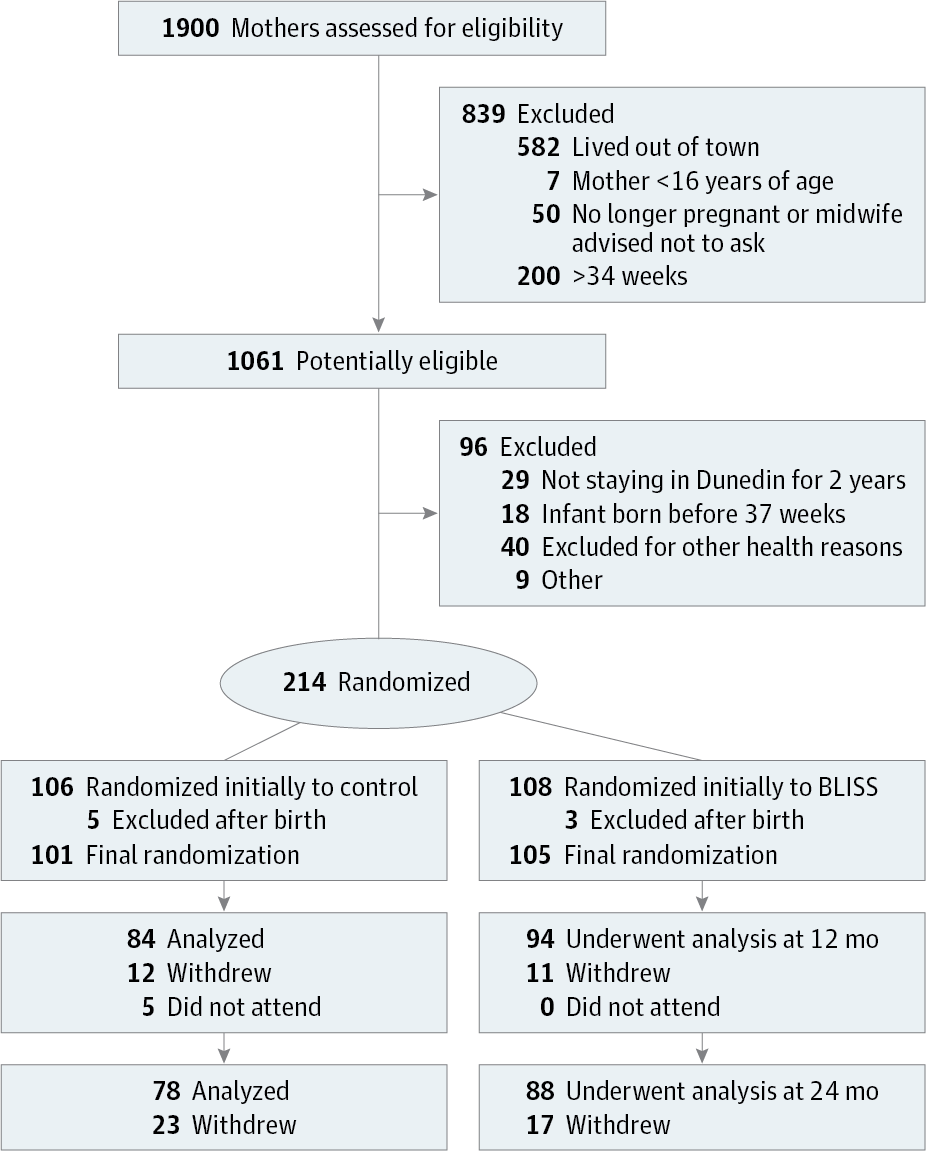当前位置:
X-MOL 学术
›
JAMA Pediatr.
›
论文详情
Our official English website, www.x-mol.net, welcomes your
feedback! (Note: you will need to create a separate account there.)
Effect of a Baby-Led Approach to Complementary Feeding on Infant Growth and Overweight
JAMA Pediatrics ( IF 24.7 ) Pub Date : 2017-09-01 , DOI: 10.1001/jamapediatrics.2017.1284 Rachael W. Taylor 1 , Sheila M. Williams 2 , Louise J. Fangupo 3 , Benjamin J. Wheeler 4 , Barry J. Taylor 5 , Lisa Daniels 3 , Elizabeth A. Fleming 1 , Jenny McArthur 1 , Brittany Morison 3 , Liz Williams Erickson 3 , Rhondda S. Davies 1 , Sabina Bacchus 3 , Sonya L. Cameron 4 , Anne-Louise M. Heath 3
JAMA Pediatrics ( IF 24.7 ) Pub Date : 2017-09-01 , DOI: 10.1001/jamapediatrics.2017.1284 Rachael W. Taylor 1 , Sheila M. Williams 2 , Louise J. Fangupo 3 , Benjamin J. Wheeler 4 , Barry J. Taylor 5 , Lisa Daniels 3 , Elizabeth A. Fleming 1 , Jenny McArthur 1 , Brittany Morison 3 , Liz Williams Erickson 3 , Rhondda S. Davies 1 , Sabina Bacchus 3 , Sonya L. Cameron 4 , Anne-Louise M. Heath 3
Affiliation

|
Importance Baby-led approaches to complementary feeding, which promote self-feeding of all nonliquid foods are proposed to improve energy self-regulation and lower obesity risk. However, to date, no randomized clinical trials have studied this proposition. Objective To determine whether a baby-led approach to complementary feeding results in a lower body mass index (BMI) than traditional spoon-feeding. Design, Setting, and Participants The 2-year Baby-Led Introduction to Solids (BLISS) randomized clinical trial recruited 206 women (168 [81.6%] of European ancestry; 85 [41.3%] primiparous) in late pregnancy from December 19, 2012, through March 17, 2014, as part of a community intervention in Dunedin, New Zealand. Women were randomized to a control condition (n = 101) or the BLISS intervention (n = 105) after stratification for parity and education. All outcomes were collected by staff blinded to group randomization, and no participants withdrew because of an adverse event. Data were analyzed based on intention to treat. Interventions Mothers in the BLISS group received lactation consultant support (≥5 contacts) to extend exclusive breastfeeding and delay introduction of complementary foods until 6 months of age and 3 personalized face-to-face contacts (at 5.5, 7.0, and 9.0 months). Main Outcomes and Measures The primary outcome was BMI z score (at 12 and 24 months). Secondary outcomes included energy self-regulation and eating behaviors assessed with questionnaires at 6, 12, and 24 months and energy intake assessed with 3-day weighed diet records at 7, 12, and 24 months. Results Among the 206 participants (mean [SD] age, 31.3 [5.6] years), 166 were available for analysis at 24 months (retention, 80.5%). The mean (SD) BMI z score was not significantly different at 12 months (control group, 0.20 [0.89]; BLISS group, 0.44 [1.13]; adjusted difference, 0.21; 95% CI, −0.07 to 0.48) or at 24 months (control group, 0.24 [1.01]; BLISS group, 0.39 [1.04]; adjusted difference, 0.16; 95% CI, −0.13 to 0.45). At 24 months, 5 of 78 infants (6.4%) were overweight (BMI≥95th percentile) in the control group compared with 9 of 87 (10.3%) in the BLISS group (relative risk, 1.8; 95% CI, 0.6-5.7). Lower satiety responsiveness was observed in BLISS infants at 24 months (adjusted difference, −0.24; 95% CI, −0.41 to −0.07). Parents also reported less food fussiness (adjusted difference, −0.33; 95% CI, −0.51 to −0.14) and greater enjoyment of food (adjusted difference, 0.25; 95% CI, 0.07 to 0.43) at 12 months in BLISS infants. Estimated differences in energy intake were 55 kJ (95% CI, −284 to 395 kJ) at 12 months and 143 kJ (95% CI, −241 to 526 kJ) at 24 months. Conclusions and Relevance A baby-led approach to complementary feeding did not result in more appropriate BMI than traditional spoon-feeding, although children were reported to have less food fussiness. Further research should determine whether these findings apply to individuals using unmodified baby-led weaning. Trial Registration http://anzctr.org.au Identifier: ACTRN12612001133820
中文翻译:

以婴儿为主导的补充喂养方法对婴儿生长和超重的影响
重要性 婴儿主导的辅食喂养方法,促进所有非流质食物的自我喂养,旨在改善能量自我调节和降低肥胖风险。然而,迄今为止,还没有随机临床试验研究过这个命题。目的 确定以婴儿为主导的添加辅食的方法是否会导致比传统勺子喂养更低的体重指数 (BMI)。设计、设置和参与者 为期 2 年的婴儿主导的固体介绍 (BLISS) 随机临床试验招募了 206 名妇女(168 名 [81.6%] 欧洲血统;85 名 [41.3%] 初产妇)自 2012 年 12 月 19 日起,直到 2014 年 3 月 17 日,作为新西兰但尼丁社区干预的一部分。在对产次和教育进行分层后,女性被随机分配到对照条件(n = 101)或 BLISS 干预(n = 105)。所有结果均由对随机分组不知情的工作人员收集,没有参与者因不良事件退出。基于意向治疗分析数据。干预 BLISS 组的母亲接受哺乳顾问支持(≥5 次接触),以延长纯母乳喂养和延迟添加辅食直至 6 个月大,以及 3 次个性化的面对面接触(5.5、7.0 和 9.0 个月)。主要结果和测量 主要结果是 BMI z 评分(在 12 和 24 个月时)。次要结果包括在 6、12 和 24 个月时通过问卷评估的能量自我调节和饮食行为,以及在 7、12 和 24 个月时通过 3 天称重饮食记录评估的能量摄入。结果 在 206 名参与者中(平均 [SD] 年龄,31.3 [5.6] 岁),166 个在 24 个月时可用于分析(保留,80.5%)。平均 (SD) BMI z 评分在 12 个月(对照组,0.20 [0.89];BLISS 组,0.44 [1.13];调整后差异,0.21;95% CI,-0.07 至 0.48)或 24 个月时没有显着差异(对照组,0.24 [1.01];BLISS 组,0.39 [1.04];调整后的差异,0.16;95% CI,-0.13 至 0.45)。在 24 个月时,对照组 78 名婴儿中有 5 名 (6.4%) 超重(BMI≥95%),而 BLISS 组 87 名婴儿中有 9 名 (10.3%)(相对风险,1.8;95% CI,0.6-5.7) )。在 24 个月时在 BLISS 婴儿中观察到较低的饱腹感反应(调整后的差异,-0.24;95% CI,-0.41 至 -0.07)。父母还报告了较少的食物挑剔(调整后的差异,-0.33;95% CI,-0.51 至 -0.14)和更喜欢食物(调整后的差异,0.25;95% CI,0.07 至 0。43) 在 12 个月的 BLISS 婴儿中。12 个月时能量摄入的估计差异为 55 kJ(95% CI,-284 至 395 kJ),24 个月时为 143 kJ(95% CI,-241 至 526 kJ)。结论和相关性 以婴儿为主导的添加辅食的方法并没有比传统的勺子喂养产生更合适的 BMI,尽管据报道儿童对食物的挑剔程度较低。进一步的研究应该确定这些发现是否适用于使用未经改良的婴儿主导断奶的个体。试用注册 http://anzctr.org.au 标识符:ACTRN12612001133820 尽管据报道儿童对食物的挑剔程度较低。进一步的研究应该确定这些发现是否适用于使用未经改良的婴儿主导断奶的个体。试用注册 http://anzctr.org.au 标识符:ACTRN12612001133820 尽管据报道儿童对食物的挑剔程度较低。进一步的研究应该确定这些发现是否适用于使用未经改良的婴儿主导断奶的个体。试用注册 http://anzctr.org.au 标识符:ACTRN12612001133820
更新日期:2017-09-01
中文翻译:

以婴儿为主导的补充喂养方法对婴儿生长和超重的影响
重要性 婴儿主导的辅食喂养方法,促进所有非流质食物的自我喂养,旨在改善能量自我调节和降低肥胖风险。然而,迄今为止,还没有随机临床试验研究过这个命题。目的 确定以婴儿为主导的添加辅食的方法是否会导致比传统勺子喂养更低的体重指数 (BMI)。设计、设置和参与者 为期 2 年的婴儿主导的固体介绍 (BLISS) 随机临床试验招募了 206 名妇女(168 名 [81.6%] 欧洲血统;85 名 [41.3%] 初产妇)自 2012 年 12 月 19 日起,直到 2014 年 3 月 17 日,作为新西兰但尼丁社区干预的一部分。在对产次和教育进行分层后,女性被随机分配到对照条件(n = 101)或 BLISS 干预(n = 105)。所有结果均由对随机分组不知情的工作人员收集,没有参与者因不良事件退出。基于意向治疗分析数据。干预 BLISS 组的母亲接受哺乳顾问支持(≥5 次接触),以延长纯母乳喂养和延迟添加辅食直至 6 个月大,以及 3 次个性化的面对面接触(5.5、7.0 和 9.0 个月)。主要结果和测量 主要结果是 BMI z 评分(在 12 和 24 个月时)。次要结果包括在 6、12 和 24 个月时通过问卷评估的能量自我调节和饮食行为,以及在 7、12 和 24 个月时通过 3 天称重饮食记录评估的能量摄入。结果 在 206 名参与者中(平均 [SD] 年龄,31.3 [5.6] 岁),166 个在 24 个月时可用于分析(保留,80.5%)。平均 (SD) BMI z 评分在 12 个月(对照组,0.20 [0.89];BLISS 组,0.44 [1.13];调整后差异,0.21;95% CI,-0.07 至 0.48)或 24 个月时没有显着差异(对照组,0.24 [1.01];BLISS 组,0.39 [1.04];调整后的差异,0.16;95% CI,-0.13 至 0.45)。在 24 个月时,对照组 78 名婴儿中有 5 名 (6.4%) 超重(BMI≥95%),而 BLISS 组 87 名婴儿中有 9 名 (10.3%)(相对风险,1.8;95% CI,0.6-5.7) )。在 24 个月时在 BLISS 婴儿中观察到较低的饱腹感反应(调整后的差异,-0.24;95% CI,-0.41 至 -0.07)。父母还报告了较少的食物挑剔(调整后的差异,-0.33;95% CI,-0.51 至 -0.14)和更喜欢食物(调整后的差异,0.25;95% CI,0.07 至 0。43) 在 12 个月的 BLISS 婴儿中。12 个月时能量摄入的估计差异为 55 kJ(95% CI,-284 至 395 kJ),24 个月时为 143 kJ(95% CI,-241 至 526 kJ)。结论和相关性 以婴儿为主导的添加辅食的方法并没有比传统的勺子喂养产生更合适的 BMI,尽管据报道儿童对食物的挑剔程度较低。进一步的研究应该确定这些发现是否适用于使用未经改良的婴儿主导断奶的个体。试用注册 http://anzctr.org.au 标识符:ACTRN12612001133820 尽管据报道儿童对食物的挑剔程度较低。进一步的研究应该确定这些发现是否适用于使用未经改良的婴儿主导断奶的个体。试用注册 http://anzctr.org.au 标识符:ACTRN12612001133820 尽管据报道儿童对食物的挑剔程度较低。进一步的研究应该确定这些发现是否适用于使用未经改良的婴儿主导断奶的个体。试用注册 http://anzctr.org.au 标识符:ACTRN12612001133820











































 京公网安备 11010802027423号
京公网安备 11010802027423号